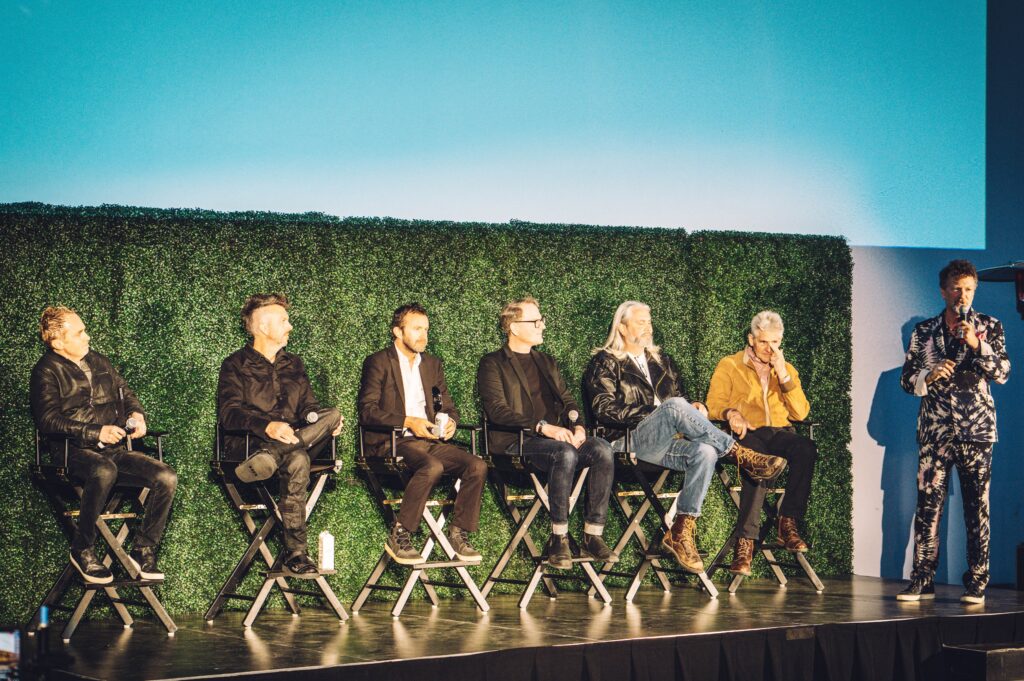
Electric Revolutionaries Panel:
Paul d’Orléans (PDO): I’m super excited, this is our second electric vehicle exhibit! Our previous one was Electric Revolution – and you know that was the first electric motorcycle exhibit in a museum in the world… and this is probably the second, because there are not that many museums that are showcasing the incredible advances in design and technology that’s happening on two wheels in the electric sphere. It’s fun to be at the cutting edge; it feels a little lonely at times, but the great thing is when you ask someone who’s kind of put their career on the line for electric vehicles they’re really grateful for the opportunity to display their work and to talk about it. Because even though it seems like it’s ‘in the air’ that electric vehicles are coming they’re coming they’re coming, the motorcycle industry has not had quite the push or quite the acceptance that the car industry has had. So it’s tough, you know, and so people are really putting a lot of money and a lot of career energy on the line and I honor them for their bravery, also the incredible creativity that’s coming out.
So we have with us several designers here whose work is being shown. We also have Charles Fleming from the LA Times! We have JT Nesbitt from Curtiss Motorcycles, and formerly of Confederate Motorcycles, We have Derek Dorresteyn, formerly of Alta Motorcycles, and now he’s working with Damon on incredible high-speed electric motorcycles. We have Hugo Eccles who’s an independent designer, he’s partnered with Zero Motorcycles on the XP0 that’s inside. We have Joey Ruiter who’s on the far-out fine art tip he; was called an alien by one of my team and I think it’s kind of suitable as his work is completely wild and out there. We have Storm Sondors whose work is on the front of the island and who is really pushing for kind of a mass-market, high sales volume, but his designs are also really cool. I love that Metacycle, the design is really cool.
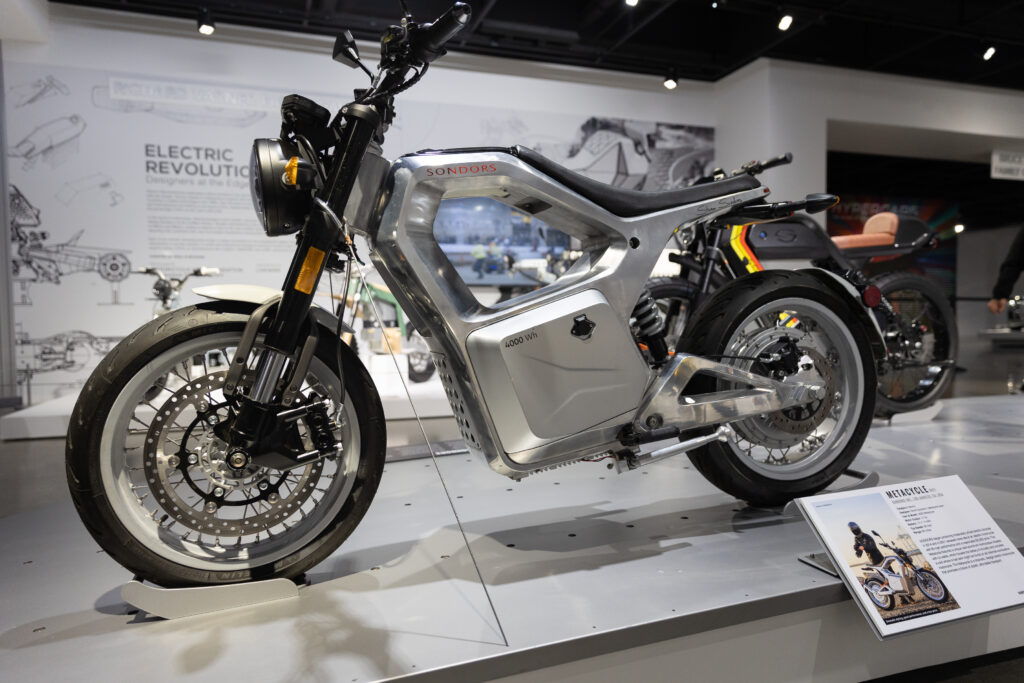
PDO: So, I’ll ask each of them in turn a few questions and at the end we’ll we can talk about it. Actually Storm why don’t we just start with you, um you can stand up, I like that [Laughter].
Storm: The last time I sat was a long time ago. I remember you [to Charles Fleming] from years ago, it was fun and yeah we’re still talking I guess.
PDO: I used his research for your bio placard, because he’s done the most comprehensive story on you in the LA Times. So, your vehicles are very cost conscious, you’re very production conscious and production economics conscious, and in a way that seems successful. You’ve found great success especially with your pedelec [electric-boost] bicycles – your beach cruisers – in fact I was at Ralph Ziman’s art studio yesterday and somebody had a Sondors beach cruiser parked there…I said, ‘hey he’s going to be talking tomorrow night!’
Storm: I didn’t even know we have Beach Cruisers?
PDO: Well the fat tire pedelecs, let’s call them that…I call it a beach cruiser. You should put that in your marketing – I won’t charge you! I look at the Metacycle with this crazy open aluminum frame and how can that be an affordable and viable low-cost production motorcycle?
Storm: The way its frame is molded right so there are no welds on it. We just use the automotive tools to create that mold, and now you can just pour one piece two pieces and connect them, right? So it’s very cost-effective and quick to produce and assemble as well. But the goal at Soudors, we’re not part of the industry right? So we create our own customer, because the reality, the challenge with electric is it’s very hard to sell electric motorcycles, for example, but if you create an audience then you have a customer. That’s kind of what I always say – don’t look for people who ride motorcycles, look for people who’d never ridden one. I think last year we sold 10,000 Metacycles, and we’re starting shipping now. I would say 50 percent of them don’t have a motorcycle license, maybe even more, because it’s approachable. It’’s not threatening,f it doesn’t look like super powerful, it just looks kind of like you know, here comes the future! So that’s what works for us – creating our own customer.
PDO: And I think that I actually said the same thing in an interview earlier, that fun and approachable are the two main points for sales success. Companies like Super 73 and stuff are doing really well with extremely approachable and inexpensive .
Storm: Yeah and also cut back on the power. I mean because we learned from e-bike market that any time we’ve started creating these high-power performance e-bikes that for average person is too much. You know that was the biggest comment always – too much power – so you know of course for specialty manufacturers it’s different, but for a mass approach you have to think different.
PDO: For sure; we just reported on the Deus automobile with 2200 horsepower. The EV automobile world seems to be thinking completely differently than the e-motorcycle – or at least how you’re thinking – it’s like more power more power because they can.
Storm: Yeah of course, they don’t have to build some crazy 16-cylinder eight-valve thing to make 22 hundred horsepower. With electric, perfect.
PDO: I like that approach though, the lower- key approachable, I think it’s one avenue towards success. Thank you, your work is great work.
Storm: Thanks so much.
PDO: Yeah you can applaud him that’s cool! [Applause]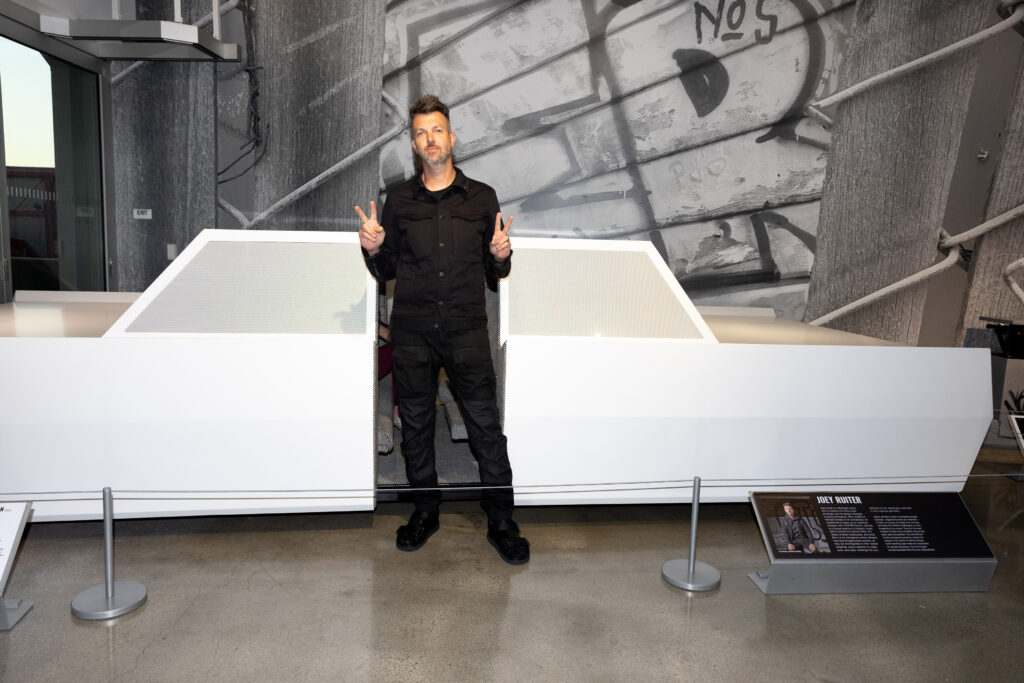
PDO: I don’t know if you’ve seen Joey Ruiters work inside the museum – Joey did the incredible bisected ‘Another Sedan’, he did the NoMoto, which looks like a piece of street furniture, I call it the first invisible scooter because it’s meant to be ignore! You can literally park it anywhere and no one will ever give it a ticket, because it looks like something you find on the street. He also designed the incredible polished aluminum Moto Undone that’s up on the island. Joey, you’ve also done internal combustion vehicles, but you seem to have shifted more to electric. Explain what’s going on?
Joey: It’s a lot easier you know, honestly there’s so many less parts; the hoses the cabling the fluids. And they usually work all the time, so it’s just a simpler platform. I’ve only pissed myself once getting shocked in the shop! Never caught on fire though.
PDO: There’s still time! [Laughs]. Your day job is as an industrial designer, you work with Steelcase on their furniture.
Joey: Um yeah I have worked with Steelcase, Herman Miller, lots of contract furniture, and boats and all sorts of stuff, like a lot of conceptual work for the marine side of things, through Brunswick. You’ve probably all sat in my chairs! A lot of my work that doesn’t look like this is like Chipotle chairs or Wendy’s or Whole Foods, so think about that next time you’re sitting in Whole Foods – think about one of my cars. [Laughter]
PDO: Would that they would use your cars! Did you ever think about doing production for your vehicles or are they purely conceptual?
Joey: You know I learn a lot when I build and design the vehicle, so I take that knowledge and then bring it to other simpler things like furniture and baby products and whatnot. So it’s really a learning experience, and then I get to flex my muscles a little bit in this world. That’s something a lot of auto designers can’t do (or don’t think they can do) especially as I have no rules, so as an artist I can freely express myself and kind of play and break rules that don’t really exist yet.
PDO: Well the work is phenomenal, and we’re really honored. This is the second time we’ve featured Joey’s work; we actually had the Moto Undone, but only for like three weeks in Electric Revolution, so it’s nice to have it back for the full year.
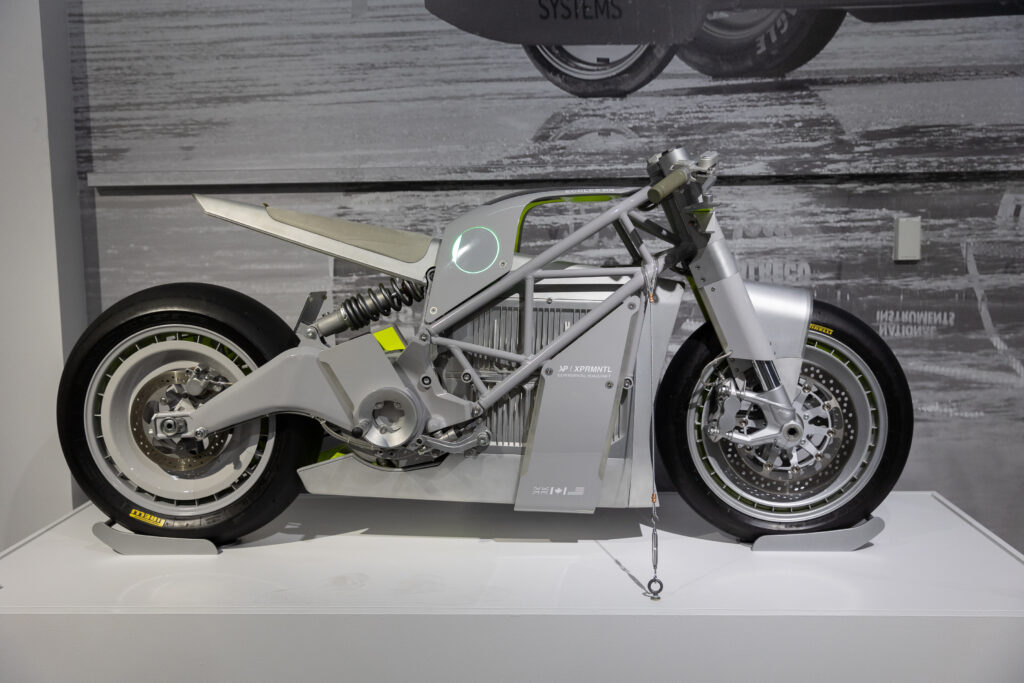
PDO: Hugo, you too are a jobbing industrial designer who’s kind of stepped over into the motorcycle world. Have motorcycles become your primary focus, or are you still doing other stuff to make money?
Hugo: Yeah they’re the primary focus. I’m also an industrial design professor, so I kind of keep my hand in in that way. It’s interesting, I think maybe similar to Joey, i’m not a professionally trained automotive designer.
PDO: Which is maybe why your work is so cool?
Hugo: Well thank you very much, I mean, I think it helps because I don’t know what the stupid questions are, right? You know in some strange way my ignorance is a great asset, because on a lot of occasions I don’t know something’s impossible, and because because I’m so ignorant of that, you know, you just go try it you know. So it helps in a way. I think sometimes disciplines become quite dogmatic, and can suffer from the whole ‘if the only tool you have is a hammer every problem looks like a nail,’ and you get a lot of automotive design solutions look like automotive design solutions.
PDO: I totally agree.
Hugo: Because I’m not trained in that.
PDO: Well I think your XP0 is a brilliant design, and you’ve won tons of awards and we’re super happy to have it here.
Hugo: Thank you
PDO: I do want to ride it too!
Hugo: Oh well, I think that’s the thing that surprises people sometimes; it’s a fully functioning rideable motorcycle. Although slightly intentionally doesn’t look like one, right? I do quite like to kind of confound expectations sometimes, so it doesn’t look like it should.
PDO: Well, I think it’s really cool.
Hugo: Thanks for exhibiting it.
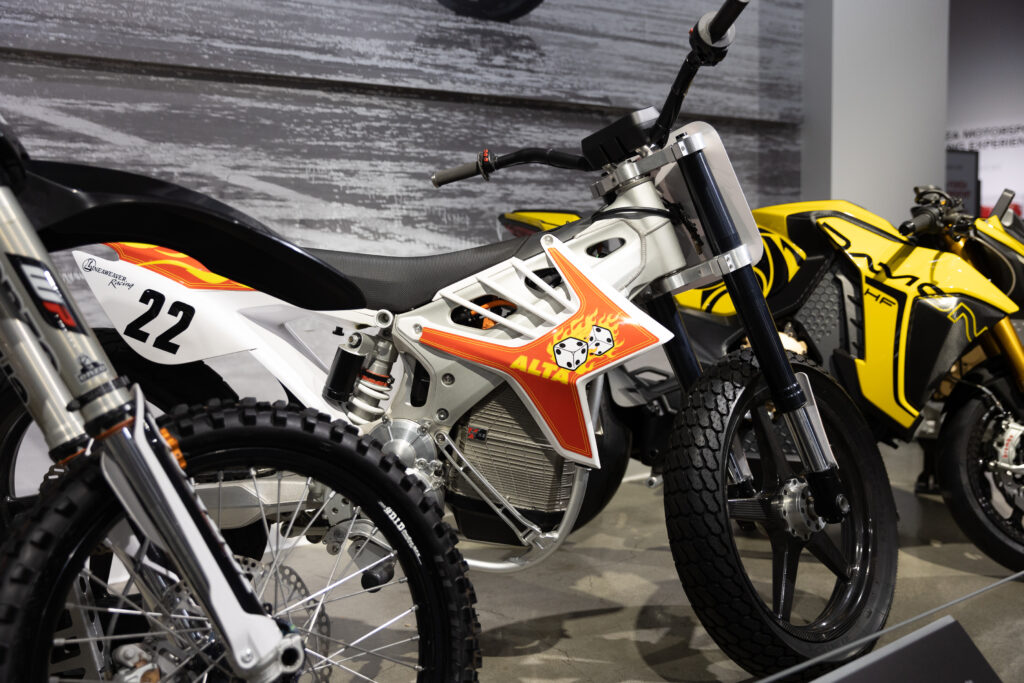
PDO: I’ve known Derek Dorresteyn since 1985 or ’86, something like that, we used to share a warehouse in Bayview in San Francisco, and he was starting his Moss Machine business. I started to hear whispers, um gosh almost 15 years ago that he was thinking about manufacturing an electric motorcycle, and I was like wow that’s like out there! That work eventually became Alta Motorcycles, and there are three Altas in the exhibit! One that Walt Siegl built and two that are modified for racing, one of which was very successful. Do you want to tell us a story about your motocrosser?
Derek: Yeah we got involved. My partners Jeff Sand and Mark Fenigstein are here tonight. Anyway, we decided it would be really great to promote the brand if we if we got involved in some sort of racing, and the first event that we were invited to race was a professional race against factory teams, and we just took that on. We thought, you know, why not, we’ll go out and we’ll try to do this. So the bike that’s on display there raced in a a one-off event called Red Bull Straight Rhythm, that was a sort of motocross track stretched out into a single line. With the rider Josh Hill we raced against factory Honda, factory Suzuki, Kawasaki, KTM. We didn’t beat KTM but we beat everybody else. And that really was this sort of moment in history where electric showed the promise of being, you know, better than gas!
When it was passing the Suzuki on the track, people noticed, yeah it was a big deal, and that was literally our first race.
PDO: Wow I didn’t realize that. I remember the testing rig you had in your original facility, it was this old brewery with this huge tower and you said ‘the chassis testing is to drop it like 60 feet onto a concrete floor to see if it’s strong enough! That was impressive.
Derek: Well it wasn’t quite 60 feet but it seemed like a thousand! We did drop testing; we first drop tested a competitor chassis from one of those reputable companies in Japan and we learned what the limits were, and then we made something that was a little better than that. We weren’t sure really what it was going to take to survive some of the abuse you see out there in the world of motocross.
PDO: I should say that Derek was a professional racer, so he brought a particular perspective to manufacturing. And now you’re working with Damon as Chief Technical Officer. You’ve got whole Damons inside plus the hyperdrive chassis; it’s a totally new concept of how to power a motorcycle. It’s like monocoque chassis, battery and engine all in one, you just kind of bolt everything around it and boom.
Derek: I’m super excited about that. I joined Damon a couple years ago when I met Dominic Kwang who’s here tonight who’s the co-founder of Damon with Jay Giroud, and we hit it off and started talking about, you know, me getting involved, and eventually I became involved with the company. The Hyperdrive that you see in there, and the way that that all goes together is certainly something new, and we think it delivers some performance and some utility that really has been missing, and it sort of makes a large-scale motorcycle possible. It makes it compete on performance, on cost, on mass, all these things that it’s been really hard to solve for, right: Usually you get two of them, but you don’t get all three, and with this this configuration for us is delivering all three of those things.
PDO: 200 horsepower, 200 miles per hour, yeah pretty amazing!
Derek: You know, Mr Sondors brought up this point about performance, and Damon is focused on highway legal bikes. If you have something that can go 70/ 8 0 /90 miles an hour you realize really fast that you need a lot of battery, because it takes a lot of energy to push through the air. We’ve got 20 kilowatt hours of battery within that hyperdrive; you have the option to have a lot of power too, we thought that would be fun and exciting and we thought it gave an opportunity to sort of replace the gas bike, right? You know there’s no compromise here, right? You’ve got the acceleration, you’ve got the range, you’ve got the peak power, you’ve got everything the gas bike does, except it’s quiet and more accessible.
PDO: If you have a chance take a look at the Damon stand over there, and ask questions, and see their demonstration, and also check out the Hyperdrive chassis that’s sitting inside.
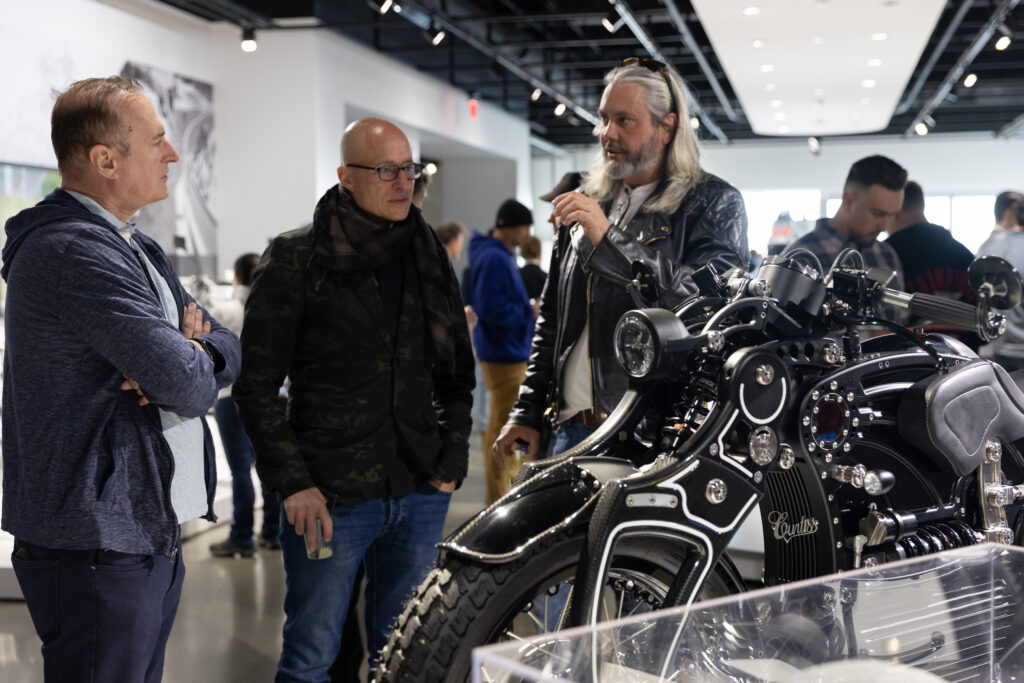
PDO: Inside we have another chassis, but a totally different concept and design and mentality from the Curtiss motorcycle. JT Nesbitt designed this iteration of the Curtis called The One, and it’s different from everything else. The focus is on something exquisite and expensive and bespoke and unique. Do you all remember the Confederate Wraith? Brilliant bike, I actually rode one, but I have not ridden your Curtiss, yet though there’s still hope!
It’s a very unique approach, making something that’s bespoke and expensive and beautifully designed without compromise, it’s a particular vision, and it looks like no other motorcycle. I know you’re a fan of big fan of technology and things like Japanese steels and durability, and you were talking earlier about things that last. [To the audience] He’s got a samurai sword that’s 700 plus years old and is using that as kind of his talisman of what design can be.
JT: Motorcycles are my religion and the most important thing to me is sustainability, and I think the way that you achieve sustainability is not just through the technical design of the machine with replaceable components etc. It’s about beauty. Beautiful things very rarely wind up in a landfill. So yeah, beauty is eternal. And I want to focus on beauty and proportion and I’m a motorcycle guy. That’s what I really actually care about, it’s all I care about: motorcycles.
PDO: Right on, I think you’ve got an audience here, and a panel of people who totally agree with you. It’s a fascinating thing and totally different to enter the market in this way and I don’t even know if you’re thinking about the market per se, or just producing this thing that’s so exquisite that you’re sure that people will want it.
JT: What you’re talking about is sales. That and money are an outcome; that’s not a goal, that’s something that that happens when you do the right thing.
PDO: That’s a beautiful way of approaching your work for sure. It’s an exquisite motorcycle.
JT: Thank you, and you haven’t even ridden it yet.
PDO: I haven’t even ridden it yet but visually it’s stunning.
JT: Give it a give it a half an hour, and pore over the details, it’s amazing.
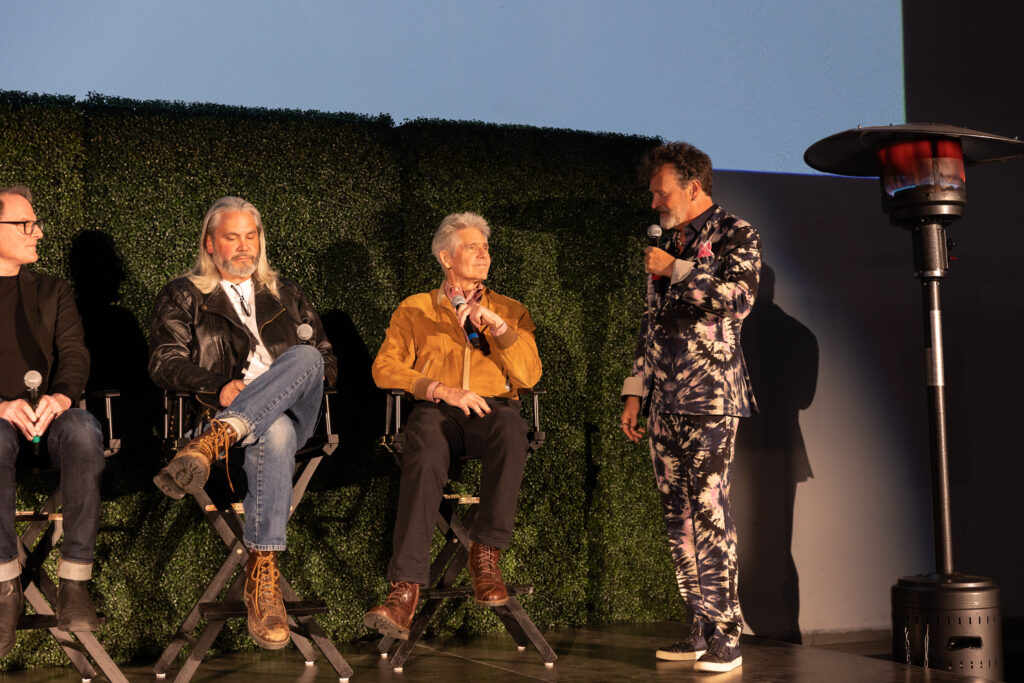
PDO: Charles Fleming from the LA Times, who has been on our panels before, you have five incredibly different designers with different head spaces and different attitudes. I mean what do you see as a member of the press is – how’s the electric motorcycle industry doing? I don’t mean sales but in terms of the culture in general?
Charles: Well the mainstream media follows the mainstream market I think, so newspapers like the LA Times and the New York Times and Wall St Journal, because there hasn’t been a Tesla motorcycle yet that has become chic, that sales have begun to run away to they can’t make them fast enough… because that hasn’t happened yet, I think the mainstream media is still waiting for something to happen. And the mainstream media tends to ask about electric motorcycles the same sort of dumb questions that the average consumer is likely to ask; they’ll ask you two things. I’ll say I’m riding this electric motorcycle, and it’s so wonderful, and they’ll ask two questions: how much does it cost, and what’s the range: No matter the answer it’s unacceptable. It’s unacceptable whatever the number you give them; for range they’ll tell you, you could say 400 miles and then you’ve got to wait for three hours. “I’m a real motorcycle guy i could never do that.” And whatever the price is, that’s too much, that’s ridiculous, and I think partly this is because for some reason it seems to be perceived as an either or; fare you an electric guy or are you a gas guy, like are you a real motorcycle rider or are you an electric motorcyclist? As if somehow you and I were talking about this; Who has one motorcycle? Nobody has one motorcycle. Almost everybody has more than one because they do different things, but this idea that somehow you’re not a real motorcycle guy if you’re on an electric motorcycle. Until somebody rides one, and then their mind is blown and they want to ride it! I think the motorcycling press, the endemic press, absolutely gets it, but maybe sort of watching for something to happen. That makes it make sense for them to cover it, for our mass market because the average consumer hasn’t arrived yet, and I don’t think it’s because the product is not there. There’s good product, there’s been good product, and I don’t think it’s really even the price point, either. I think there’s something about the mentality of it, that somehow people are just still resistant to the idea.
I’ve riddent the Alta that Derek was behind, I’ve admired Hugo’s work for a long time, I’ve ridden all the bikes that Zero makes and I’ve ridden the LiveWire and some of the others. They’re magnificent experiences.
PDO: I think electric bikes are way more fun than electric cars.
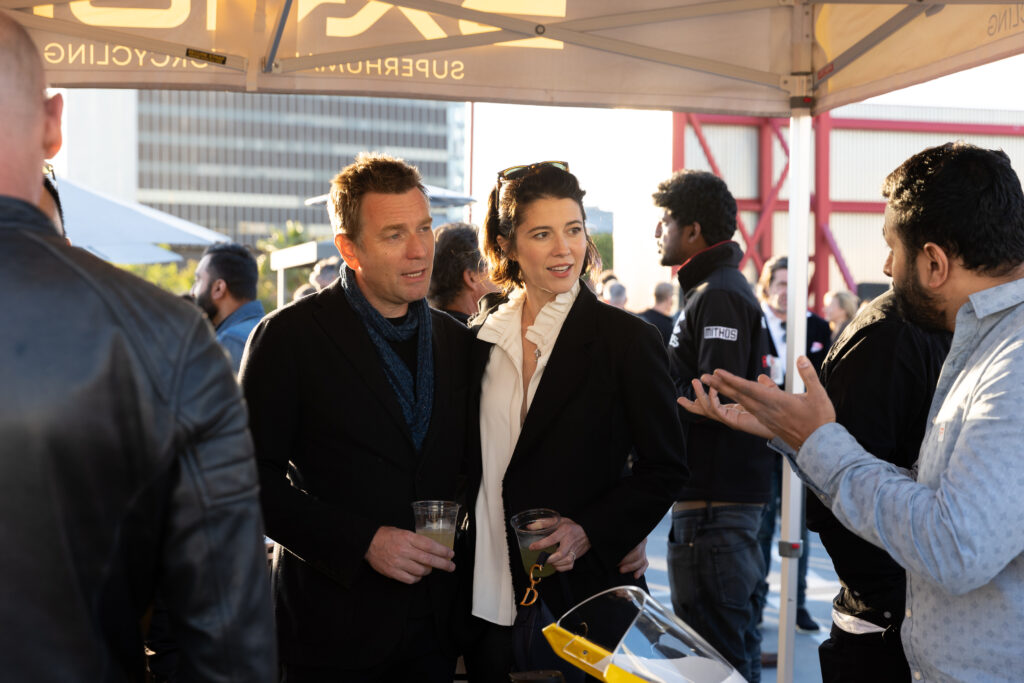
Charles: Oh way more fun, yeah. Because you have much more of that ‘magic carpet’ feeling of somehow you have conquered gravity, you’ve conquered time, all you have this magic carpet experience of suddenly flying through the air with none of the distraction of noise and vibration and smell and so on. I think it’s a magical experience.
JT: Because you don’t have those distractions; suspension and ergonomics become really important. Because there’s no masking bad ergonomics, you have nothing else to think about, there’s no masking bad suspension. Because that’s all there is.
Charles: And as the car makers have found a great challenge too. If there’s something that squeaks or rattles – oh my heavens – you really know, that’s all you can hear! Whereas in a you know big old gas motor car, you can make it do anything and nobody’ll even notice because your brains are being shaken to bits.
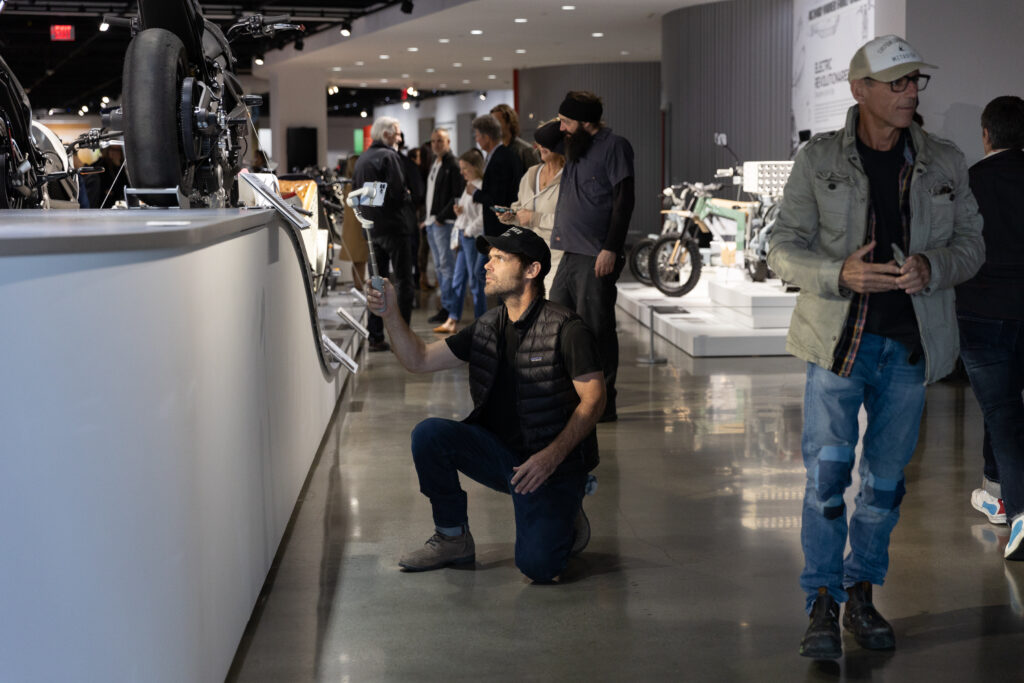
Charles: There must be an industry name for this, but when you’re not feeling vibration and heat and when you’re not doing all those things, it feels like you see better and you hear better and you smell better. I’m so much more aware of flowers and flowering trees and things when I’m – no seriously – when I’m on an electric bike, and it’s not because you can’t smell it over the smell of the motorcycle, it’s that your senses are busy doing other things, and not as available for just experiencing the whole atmosphere.
Hugo: I would agree, I mean it’s almost heretical to admit it, but you don’t really miss gears as much as you would think. And Derek has said you end up concentrating on road positioning and smoothness and you know along the old analogy of ‘slow is smooth and smooth is fast.’ Yeah you end up riding really quickly, I think the only the only criticism I would have of electric is it’s difficult to gauge how fast you’re going. Without practice you end up overcooking it into corners a lot, you think you’re going into a corner you look down and say fuck! I’m going 90 miles an hour! I should not be entering this corner at 90 miles and hour. But beyond that I mean it’s incredible you know, you have power on tap, you go to overtake something, you just pull out and you punch it, it’s like riding a rocket, it’s done, and you can you can overtake at literally the last moment and dive into a corner because all you have to worry about is braking. You don’t have to worry about trying to drop a couple of cogs and feather the clutch back in and not break the back loose and etc.

Hugo: Yeah and to reiterate something Charles said; you have this very different relationship with nature. You know I ride to Alice’s [Restaurant] near San Francisco, and you see coyote and deer and wild turkeys and stuff. I mean not it’s not like you come around the corner and there’s a cow in the road, like it’s not That silent, but they’re still hanging around, and you can smell the flowers literally.
PDO: You know I’d love to open up, if anybody has any questions because we don’t want this to go on too long because I need a drink and I can’t drink before I do these panels! That man has a hand up.
AUDIENCE QUESTIONS:
Man in audience: I have a question: I’m a LiveWire rider and I love every bit of it. What about the noise – is it safer if motorcycles make sound? I’m not talking about loud pipe-save-lives mentality. [Laughter] I’m talking acoustic beacon versus a silent machine. Is there any benefit to having a little noise?
PDO: Do loud pipes save lives?
Hugo: I think to a certain extent, I mean I have gas bikes and electric bikes, and on the mornings that I ride the electric bike my neighbors love me, and they really notice when I bring out the gas bike. But I think very soon, we’re right on the cusp of vehicle-to-vehicle communication, so in a weird way you won’t even necessarily need to make a noise. Because in the same way that line guidance will stop someone pulling into their blind spot because there’s a motorcycle there. Their car will know that, and stop them doing something stupid or will apply the brakes before they rear-end you. It really changes the game I think.
PDO: Derek, I know Damon is very focused on safety and has radar and cameras and rider warning systems; have you thought about noise?
Derek: Absolutely. We’ve spent quite a bit of time talking about noise and we continue to actually study it. We have a motorcycle that has 16 ECU’s on it, and has 16 microcontrollers on the vehicle. We’re programming all of them, and making this sort of symphony of microcontrollers to do all the special high-tech things that the Damon bike does. And one of those high-tech things is that we’ve got radars and cameras on the vehicle that are looking behind and in front of the vehicle, and they’re identifying threats; they’re looking at the trajectory of objects and they’re saying ‘hey that car is going to come in front of you’ or ‘you’re closing on an object faster than you really should,’ and it’s going to alert you to those threats. So in the Damon we have haptics in the handlebars that vibrate to alert you to those oncoming threats. And this is something that’s quite new in the industry, and it’s something that the founders in particular put a lot of effort into early on, because they think that the safety issue in motorcycles has been poorly addressed, and there’s a lot of opportunity to improve outcomes on motorcycles. And I’m all behind it, it’s great work.
PDO: It’s fascinating technology on the bike.
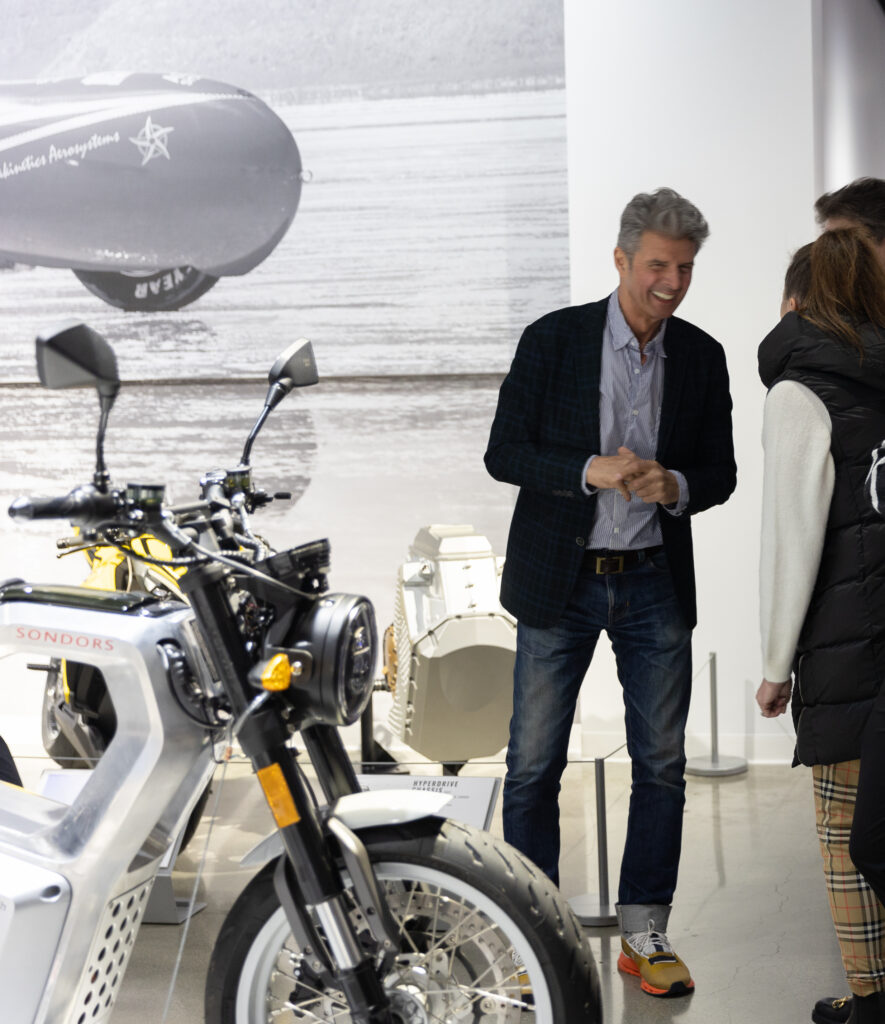
Donna Michaels: Why is this an all-male panel?
PDO: Well, we wanted to get Eva Håkkanson here – she just commented that it’s an all-male panel – sorry, we do have one woman in the show but she’s in New Zealand right now.
Donna: So, the electrification of the industry to me is not just about the switch from fossil fuels, it’s also about electrifying the rider. So, I’m 5’2” and have been riding cafe bikes and smaller bikes and I had talked to you earlier about the needs that people who might maybe not be as tall or as mobile, and not just women, to able to enjoy the [riding] experience. So, what are we going to do electrify the interest, to get more people mobile, who can ride electric bikes?
PDO: So the question is, what is the EV industry doing about access, for inclusion, especially because the motorcycle industry traditionally has been really terrible about designing motorcycles for women.
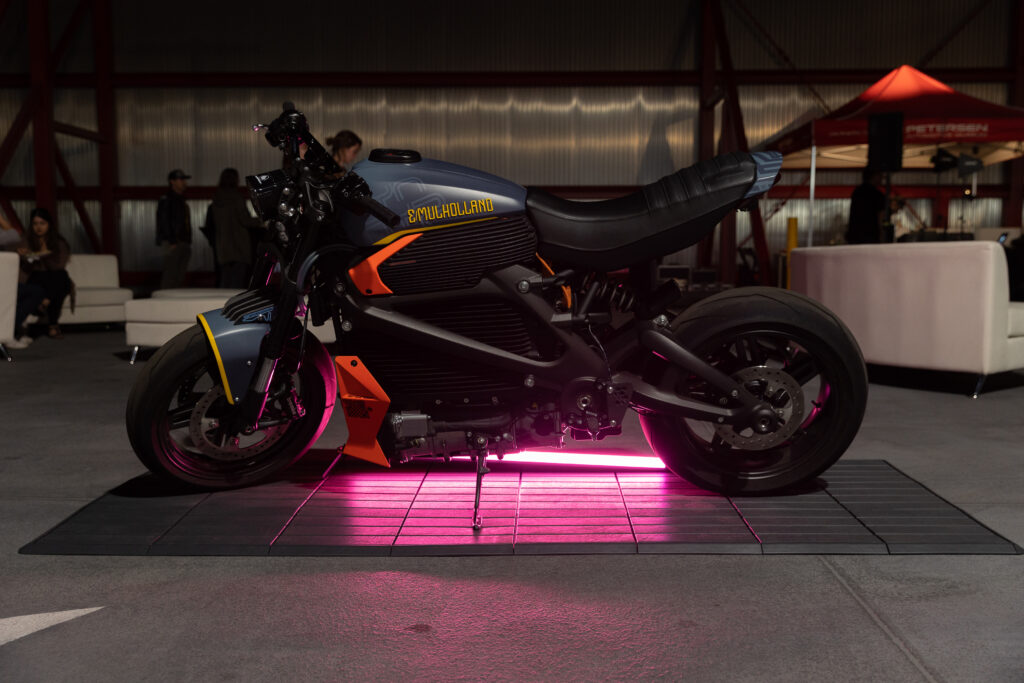
PDO: Yes you can.
JT: So, I think that half of the population – meaning women – has been entirely unserved ergonomically. You know I can spot a female rider from hundreds of yards away, and they always have a different posture in my eyes than male riders. They’re much more upright, they’re much more alert, and they always tend to grab the tank between their knees. I think part of it is because many women have equestrian backgrounds. I think that ergonomics can go a long way to solving problems for women – that means lower seat heights and adjustable seat heights. It also means understanding how a female body works ergonomically and then designing for that. I encourage you to please have a seat on our motorcycle, and give me some feedback. I’m still learning.
Charles: It might be interesting to ask Storm; do you have a sense of what percentage of your buyers have or don’t have motorcycle licenses? Do you have a sense of how they’re appealing to each gender or to the multiple genders?
Storm: Um yeah I would say probably 30 percent are women…
PDO: Which is 20 percent more than the typical 10 percent that are women motorcyclists…
Storm: You know the biggest thing is step-over height, right? So it’s about seat positioning, it’s gotta go lower, that’s the first thing. To accommodate shorter riders so they’re safe on their feet. That’s the quickest solution to a problem which intimidates a lot of people, where you are kind of tiptoeing, because we’re just building bikes for tall people, or average height (what we call average height).

PDO: You mean, male riders come in different sizes too?
Hugo: I’m not the tallest guy in the world you know, and it’s reassuring to be able to flat-foot it, but I think a lot of guys go into a dealership, and they won’t go ‘oh this is not totally reassuring. You know I remember talking to a friend of mine who’s really into bicycling and he’s like ‘how many frame sizes does this come in?’ I’m like ‘one’ and he’s like ‘what?’
PDO: A perfect example.
Derek: I don’t know what all you’re talking about, motorcycles fit perfectly. [Laughter – Derek is 6’3”]] It is really an issue and at Damon we’ve been trying to broaden the ergonomics and the percentage of different-size humans that we fit, and one of the ways to address that is with the transforming ergonomics that we have on the vehicles. So we’ve got we’ve got servo motors hooked up to the pegs and the handlebars and we can adjust the reach on both of them and to give, not quite an infinite number of positions, but really everything from a low sport bike position up to what would be considered a standard position for both pegs and handlebars. And people are really responding to that. It’s actually incredible.
PDO: Because normally it’s such a pain in the ass to change your riding position on a bike; you’ve got to buy new handlebars and maybe buy a new seat…
JT: All of our stuff is completely adjustable, but we don’t use servo motors.
PDO: Hand adjusting, that’s old-fashioned.
JT: Yeah because servo motors break.
Hugo: I mean there is that old adage ‘if it’s not there it can’t go wrong.’ Even if you look at Harley-Davidson’s Panamerica like there’s you know it has a certain clearance because it’s an off-road-ish motorcycle but it sits down when you want to get off it. So I think there’s a lot of technologies coming in where you can have adjustable suspension, so as you get to a traffic light or something, it comes down and you can put your feet on the floor, and then when you’re riding it gives you the clearance that you need. So no longer do we have to engineer these sort of compromises, the nice thing is the end the engineering or the technology is removing the compromises.
Derek: Absolutely, adjustable ride height is on the horizon for a lot of bikes, and you know when you have a very technologically integrated vehicle, you know, one more ECU is not such a big deal.
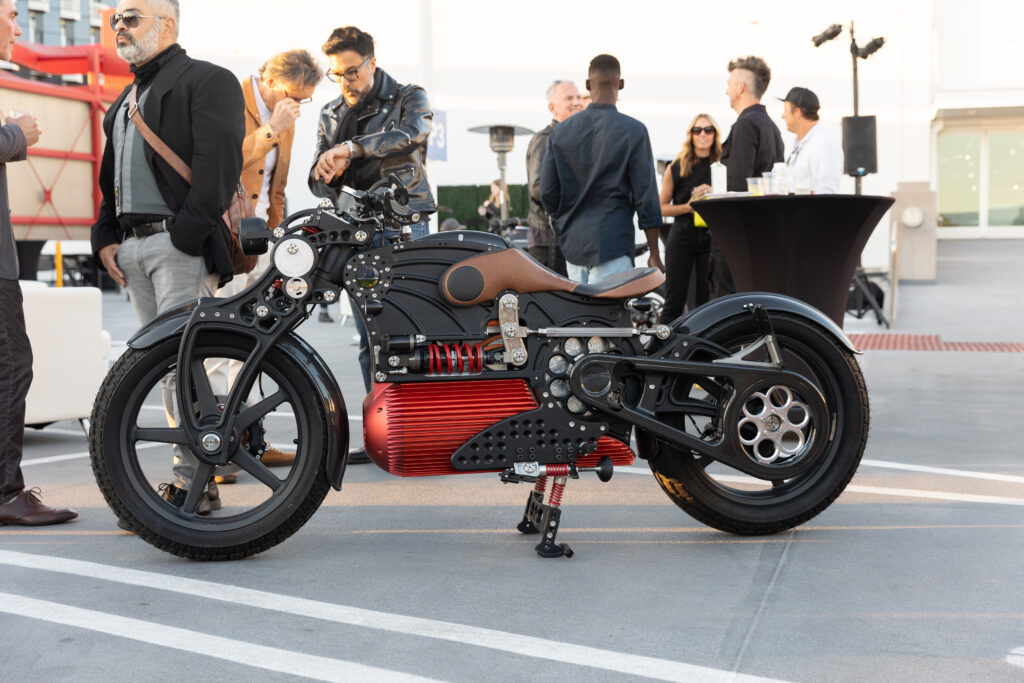
Hugo: I think JT touched on this; the assumption is that you know female ergonomics are the same as male ergonomics, just smaller. The whole ‘shrink it and pink it’ thing.
PDO: JT disagrees with you but yeah and they’re very different
JT: They ride differently.
Hugo: There’s some really interesting studies in car designs, which are literally harming female drivers because they just they’re just built around the wrong assumptions.
Derek: Yeah I think the MIC [Motorcycle Industry Council] specs or stats are that women riders are still the fastest growing segment within two wheelers, so it would serve all of us and all of our companies to focus…
PDO: Pay attention.
JT: And ultimately the way that you solve the problem is that you make the motorcycle as narrow as possible, right? The thinner it is, the better it works for women and men,
Hugo: And light motorcycles; light is good.
JT: Just lightness well more specifically your CG [center of gravity], so your overall CG is close to the roll center. The closer to the roll center the better it is.
Hugo: Lightness as well really helps, I mean there is a tendency to build very heavy bikes.
JT: Top-heavy.
PDO: All right we’re gonna have to continue this at the bar apparently [laughter] and you’re all welcome to join in the conversation with these people having a drink but we have to wrap this up. We’re way over our time but it’s been fascinating talking to all of you and hearing you talk with each other thank you all so much for participating, especially in the exhibit. Thanks.
Hugo: I’ll be at the bar.
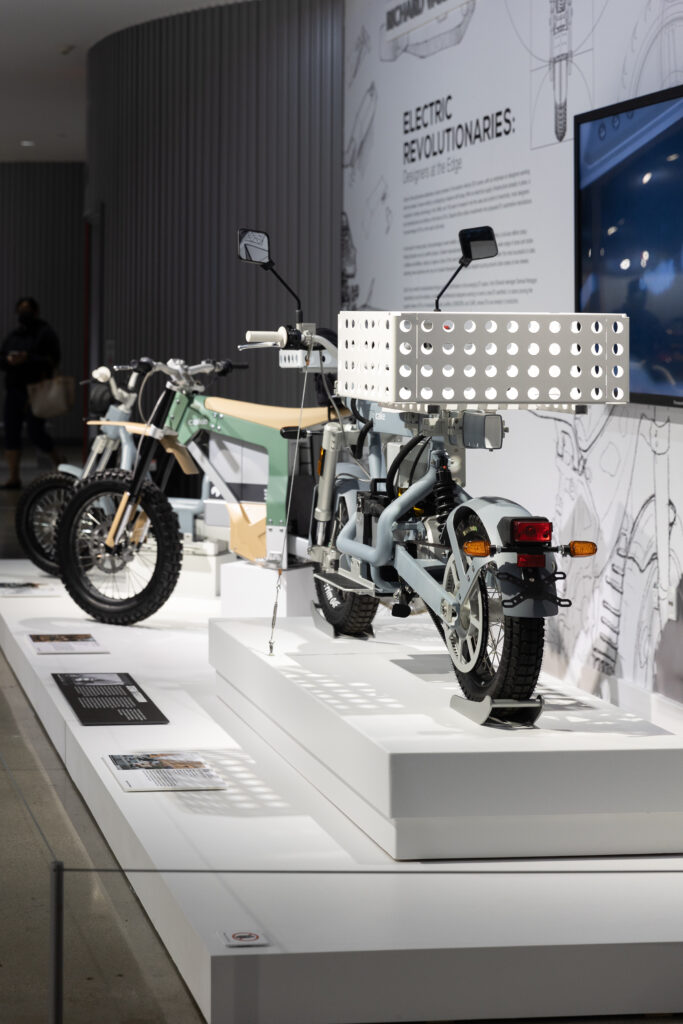
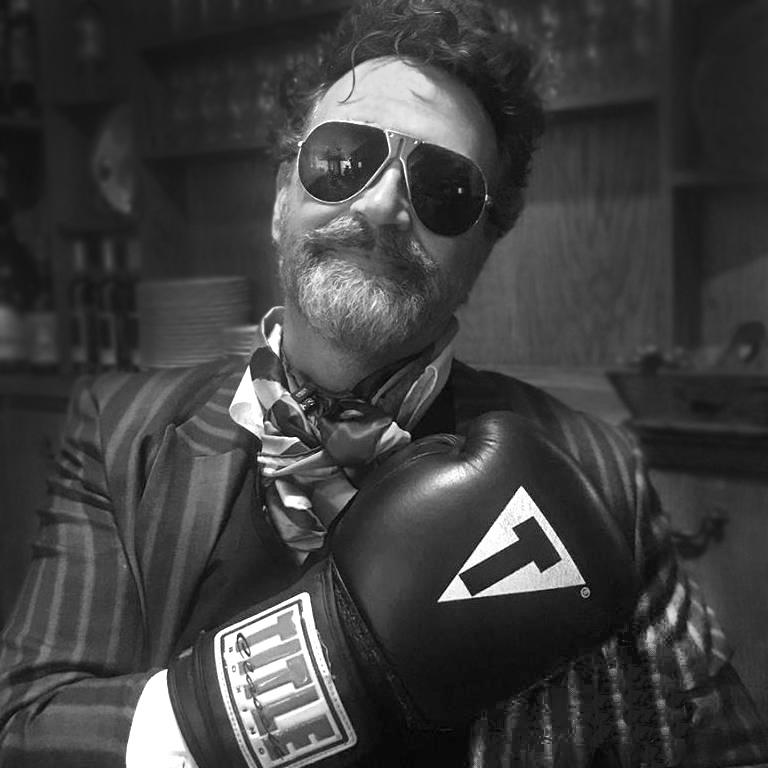


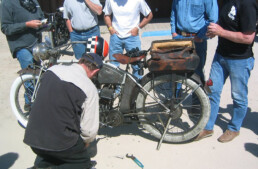
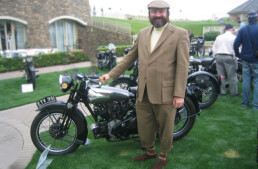
Blah blah blah . A bunch of financially motived Platitudes & Attitudes .. not one of which contains a single fact or criticism … nor is any of it coming from an Engineer . Scientist or any ‘ expert ‘ of any kind
In other words … the very worst example of an Infomercial … from word one to the bottom
Shame on y’all !
Now wheres that manure shovel so I can dig my way outta here .
FYI ; So Pd’O … you subscribing to the Revisionist Dictionary as well mate .. or just a bit of blatant hyperbole ?
ref ; ” Revolutionaries ”
Cause to be honest … though I see some mighty fine custom bike builders and designers … they aint an Electric Revolutionary ( or any other kind of revolutionary for that matter ) .. or even an electric ‘ innovator ‘ .. in the bunch
Sorry to be so blunt but errr … facts is facts
* Nicola Tesla was a revolutionary . .. whereas Elon Musk and his TESLA .. is just another case of repackaged and marketed ” a fool and his/her money ” SSDD
Now please … do me a favor so I can post something genuinely positive just once on this column !!
Feature the damn H-D LiveWire S2 that just hit the public eye .
You’ll be pleasantly shocked and reposed if you do